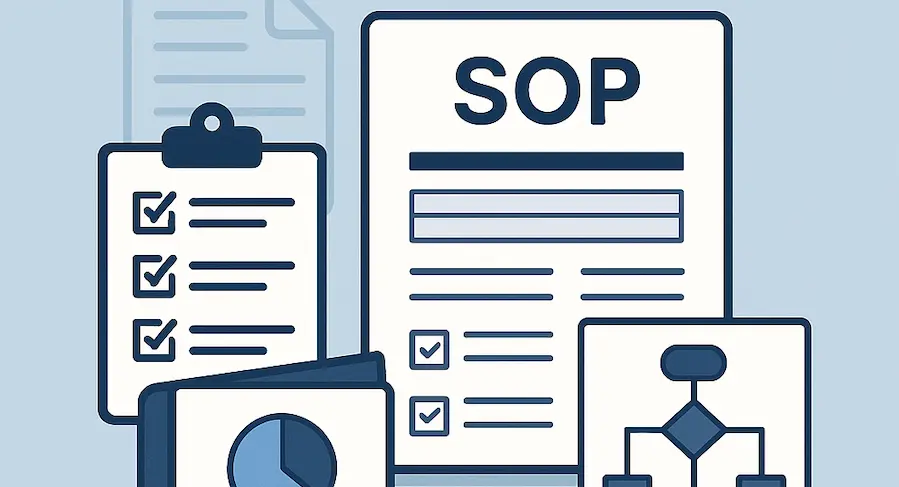
A knowledge base doesn't just help improve employee productivity with tips and guides on your company's inner processes. It can effectively drive sales, too. A 2022 Customer Experience Trends report shows that 89% of customers spend more with companies that let them find answers online without contacting support.
No matter your niche, there's no excuse for not having a thorough, easily accessible ultimate guide for both your employees and customers. In this article, we'll show you how to create a knowledge base you can adjust to your industry, target audience and any business process. We'll also help you find the right knowledge base software to help you create SOPs and problem-solving articles faster.
How to create a knowledge base: Creating your information hub
Follow our step-by-step guide to create a knowledge base that's useful, easy to do and always up to date.
Identify your audience and topics to cover
Before you start looking for knowledge base tools or decide what you need to document, consider your target audience. Understand the specific requirements, age, experience and expertise of your users. This will give you an idea about what topics to cover, what kind of language to use and what level of detail you need to include to make a comprehensive resource for learning and problem-solving.

Knowing who you're writing for should already give you an idea about what to document. For example, new users of your tool need to know how to implement it and learn about the basics. If they belong to an older, less tech-savvy generation, they may need simpler language, more details and clear, annotated visuals.
Drafting the initial list of topics doesn't have to be difficult. A good place to start is to talk to your customer support team. Sift through your clients' queries to see which questions they frequently ask.
Depending on the number of topics you end up with, you may need to prioritize them or sort them into thematic sections. We suggest prioritizing based on the number of times each question has been asked. By doing so, you can ensure that your knowledge base addresses the most commonly encountered issues.
Other prioritizing methods include:
- Keyword research
- Primary user persona needs
- Social media channels
- Role-based segmentation
- Prioritization scorecard
- Stephen Covey's quad chart
- Roadmaps or Kanban boards
Decide on the knowledge base structure
Here are some examples of what to consider when planning the knowledge base structure:
- Table of contents
- Instructions for using tools
- FAQs
- Step-by-step guides
- Troubleshooting guides
- Gamified learning modules
- Lists and headers to divide up the text
- Search bar
- Multimedia and interactive elements
- An indexing system
- Accessibility features (i.e., alt text for images and compatibility with screen readers)
- Links and cross-references between articles
- Wikis for collective knowledge base creation and maintenance
Adding a search bar is a must, no matter what knowledge base solution you go for. A good search function helps to save time for your curious customers who know exactly what they're looking for. They're bound to get frustrated if they don't find answers fast.
A good example of organizing your robust knowledge base is this HelpScout help center.

Research shows that 77% of customers prefer self-service tools, with digital channels being particularly on the rise in popularity. Yet, 69% of them have trouble finding the answers they're looking for on the company website, resulting in frustration.
Categorizing your knowledge base content increases customer satisfaction by helping clients quickly find answers to the questions bugging them.
Here are some other ways to organize your knowledge base better and elevate the customer experience:
- User type or role: You can break down information aimed at contractors, employees and customers. The more specific, the better, e.g., you can have a separate salesman training manual and customer service training manual.
- Activity: You can have sections for different stages, e.g., product packing, shipping and handling returns. This kind of knowledge base for SaaS users can be broken down like this: data management, user permissions, reporting and analytics, integrations and API usage.
- User stage: You can sort the knowledge base by the experience or stage of the user, for example, installation, getting started, upgrading your service, workflow tutorials and how to unsubscribe.
- Product type: This works great if you offer multiple options. For example, a consumer electronics company could have separate troubleshooting guides for smartphones, laptops, audio devices, cameras and home appliances.
Automate what you can with knowledge base software
Yes, creating a knowledge base takes time and effort. If that's one reason you haven't got one yet, don't worry. We're here to make your knowledge management easier. The solution is to use knowledge base software to automate as much as possible. Automation is a huge time-saver. The 2023 Slack State of Work report shows it can free up at least two hours weekly on various tasks – and drastically improve productivity.
The best option for creating a knowledge base with the use of automation is the SOP software MagicHow. This knowledge base tool can draft instructions and make screenshots to help you teach anyone to use software that is part of your company's tool set. It helps you by automating the process of writing documentation, step-by-step guides, manuals, instructions and tutorials with AI. Even people without any technical skills or experience won't have a problem using it.
The first step is to install MagicHow on your device. Go here to get the free browser extension (compatible with Chrome, Firefox, Edge and Safari) or here to get the Advanced desktop version.

Once the program is in place, all you have to do is press record and perform the process you wish to record as part of your company's knowledge base, as usual. In the meantime, MagicHow takes screenshots and divides what you're doing into logical steps. You don't have to do anything other than perform the process from start to finish.
When you're done, simply stop the recording. MagicHow has an artificial intelligence feature for automatic screenshot annotation. Yes, you'll be able to edit later.
Some other ways to help you automate the process of knowledge base creation include:
- Automated content classification and tagging with the use of a machine-learning algorithm
- Implementing natural language processing (NLP) algorithms to summarize and extract key information automatically
- Using web scraping tools for gathering information from reliable sources
- Integrating version control mechanisms to track changes in the knowledge base automatically in case you ever need to go back to the previous version of your how-to guides
- Adding machine translation tools to make your knowledge base accessible for speakers of different languages
Write content for the rest
MagicHow also has many options for editing content. When your knowledge base content is complete, you can customize it however you like:
- Add title steps or descriptions
- Blur sensitive information from screenshots
- Crop out distracting elements from pictures
- Add logos and change styles for consistent branding in your knowledge bases
- Replace or merge slides

Still, visuals aren't everything. You're probably going to need some longer articles, too.
However, you probably don't need to start from scratch; you may have some content already written. Look through published blog posts on your own site and replies from your customer service team – reusing and rephrasing will take less time than writing articles. Add internal links between related topics to help your customers navigate issues that interest them. This has another advantage – better positioning of your website in search engines.
While that's a good start, you can’t automate all content creation. When writing knowledge base articles, follow these best practices:
- Hire a specialist copywriter or content creation company to make sure your text is of consistently high quality; you can also delegate this task to someone from your marketing team with enough experience
- Create a style guide for them to use to ensure every knowledge base article fits your brand tone and visuals
- Ensure that your content is clear, readable, engaging and adds real value
- Find editors to check the writing after it's finished
- Include rich, interactive media
- Use bullet points and text formatting to break apart large chunks of text
- Use anchor links to help users navigate your knowledge base to other relevant topics
When in doubt, check out our comprehensive list of process documentation best practices.
Publish and share your knowledge base
All done? With MagicHow, you can share your finished knowledge base articles for easy access by:
- Exporting the self-service guide in PDF format
- Using the link configuring access settings for the file
- Copying the instructions as HTML or Markdown, which lets you post them on third-party websites
- Embedding your finished in-depth tutorials in Notion, Confluence, Zendesk, Webflow or elsewhere

Make sure your knowledge base is available for public access. Link to it in all places where people tend to need help. Add it to your main navigation menu, contact page, onboarding documents or emails introducing new tools that will be used in your company.
Update regularly
You need to update your knowledge base regularly to make sure it stays relevant and useful as your products, services or internal structure change. Screenshots and video tutorials have to reflect the current workflows.
An outdated self-serve customer support center is worse than not having a help center, as it causes frustration. No one wants unhappy customers – studies show that 61% of customers would switch to a competitor even after a single negative experience.
Based on more customer questions that come up, you may need to add a new blog post every now and then or clarify the existing ones.
Some steps you can take to keep your knowledge base information relevant include:
- Include feedback forms or buttons for providing direct suggestions
- Conduct user surveys on the usability, content and effectiveness
- Add satisfaction ratings under each guide and article
- Use analytics tools to track search terms
- Track user behavior, such as which articles are frequently visited, which ones are skipped and where users spend the most time
- Generate knowledge base reports with insights into user interactions and popular topics
- Schedule regular review meetings, e.g., after a complete onboarding period using your training manual
- Motivate staff members to contribute to the knowledge base by sharing their insights
Conclusion
If you haven't yet, create a knowledge base for your business today. It's a critical tool, no matter the industry you're in. An internal knowledge base streamlines onboarding and standardizes business processes. Having one on your own website improves customer experience by providing a self-service where clients can instantly find answers to their questions without having to contact support.
MagicHow is the best process documentation software for streamlining the building of a knowledge base. It makes the process much faster and easier by taking screenshots and annotating them while you simply perform a task you wish to teach. You can use it for any industry, from e-commerce to healthcare.
Sign up to start building a knowledge base today.


